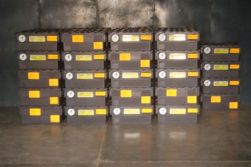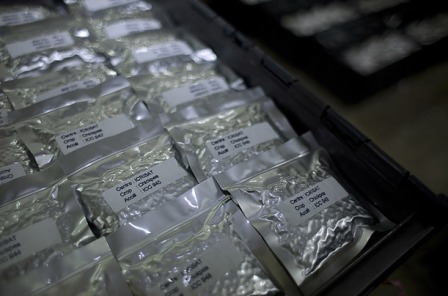Safety duplication of cultivated chickpea and wild relative genetic resources
Contributors to this page: ICRISAT, Patancheru, India (Hari D Upadhyaya, Shivali Sharma, Cholenahalli L Laxmipathi Gowda, Dintyala Sastry, Sube Singh); NBPGR, New Delhi, India (Shyam Sharma); ICARDA, Aleppo, Syria (Ahmed Amri, Kenneth Street, Natalya Rukhkyan), SARC-RIPP, Piestany, Slovak Republic (Gabriela Antalikova); Institute of Plant Genetic Resources ‘K.Malkov’, Sadovo, Bulgaria (Siyka Stoyanova); Department of Primary Industries, Victoria, Australia (Bob Redden); IPK, Gatersleben, Germany (Andreas Börner).
When should it be used
- When the original accessions are lost and no longer available and safety back-up storage is the only source for regenerating the accessions.
- To replace active/base collections, when germination is very low or nil.
- Should be located in a different country.
See also the general page on safety duplication procedures.
|
|
| Samples for safety duplication (photo: ICRISAT) |
Sample specifications
Following procedures in the Genebank Manual of ICRISAT (Upadhyaya and Laxmipathi, 2009).
Minimum sample size for storage
- Cultivated species: 100 g of seeds.
- Wild Cicer species: 200 seeds.
Viability for storage
- Cultivated species: seeds with 85% viability or more.
- Wild Cicer species: seeds with 80% viability or more.
Moisture content
- 5-7% (FAO/IPGRI standards).
Container specifications
To ensure seed viability in the genebank and en route to the users.
Specifications of packaging material
Follow procedures of the ICRISAT Genebank Manual (Upadhyaya and Laxmipathi, 2009) and FAO/IPGRI standards.
- Use three-layered standard aluminum foil packets consisting of the following layers:
- Polyester 17 g/m2 (an outer layer of 17 g Melinex and 4 g lacquer).
- Alufoil 33 g/m2 [a middle layer of 33 g (12 mm) aluminum foil and 4 g lacquer].
- Polyethylene 63 g/m2 (an inner layer of 63 g polyethylene).
- Use a packet size of 140x160 mm for holding an approximate seed quantity of 100 g.
Seed packaging method
Follow procedures of the ICRISAT Genebank Manual (Upadhyaya and Laxmipathi, 2009).
- Prepare and label the aluminum foil packets with computer generated self-adhesive labels with the accession number, identity and season of harvest.
- Take out only a few samples at the time from the drying room to minimize re-absorption of moisture by seeds.
- Weigh the amount of seed prepared for storage and fill the container with seeds having at least 2.5 cm headspace for labeling.
- Place a non-adhesive label with accession number, identity and season of harvest inside the packet.
- Seal the container using a standard vacuum sealer.
- Check for any deficiencies in packets and sealing.
- Print the date of sealing on the packet and move the samples to the long-term store.
Storage specifications
Assigning location codes in boxes
- Black-box storage based on the facilities of the centre holding the duplicate collection (e.g. in the case of ICRISAT, ICARDA seed storage location code practices).
- Use a barcode system (Genebank Information Management System, GIMS).
|
|
| Chickpea samples at the svalbard seed vault (photo: ICRISAT) |
Storage conditions
- Black-box storage at -18 to -22ºC (FAO/IPGRI standards).
- As per the Svalbard Seed Deposit Guidelines.
Shipping method
Should be safe, less costly and fast enough to avoid delays and deterioration of seed quality during transfer.
- Preferably by air-freight to the nearest destination (following international shipment practices for perishable goods).
Legal arrangements
The Centre, host country and importing centre and country policies and practices for germplasm movement for black-box storage, must be fulfilled:
- MOU for safety back-up.
- Special agreement for Svalbard.
- Certificate of origin.
- Certificate of no-commercial value.
- GMO-free certificate.
- Import permit.
- Phytosanitary certificate.
- Customs clearances.
- Others.
See also the link to the safety duplication strategies on this site, for more details.
Recording information during safety duplication
For large genebanks with active, base and safe duplication strategies, the following alternative is recommended (ICARDA Model):
- Flag of safety duplication status (Y/N).
- Number of seeds.
- Weight of seeds.
- Year of production of seeds.
- Year of safety duplication.
- Name of institute holding the safety duplicate(s).
- Box label where the sample is placed.
- Common steps (regardless of conservation strategy).
References and further reading
FAO/IPGRI. 1994. Genebank standards. Food and Agriculture Organization of the United Nations, Rome and International Plant Genetic Resources Institute, Rome. Available in English, Spanish, French and Arabic.
Nordgen. 2008. Agreement between (depositor) and the Royal Norwegian Ministry of Agriculture and Food concerning the deposit of seeds in the Svalbard Global Seed Vault. [online] The Svalbard Gloal Seed Vault, The Nordic Genetic Resource Centre, ALNARP. Available from: http://www.nordgen.org/sgsv/scope/sgsv/files/SGSV_Deposit_Agreement.pdf.
Upadhyaya HD, Laxmipathi Gowda CL. 2009. Managing and Enhancing the Use of Germplasm – Strategies and Methodologies. Technical Manual no. 10. Patancheru 502 324, Andhra Pradesh, India: International Crops Research Institute for the Semi-Arid Tropics. 236 pp.
Comments
- No comments found



Leave your comments
Post comment as a guest